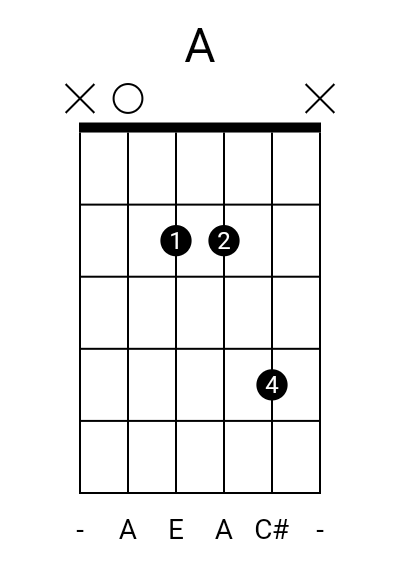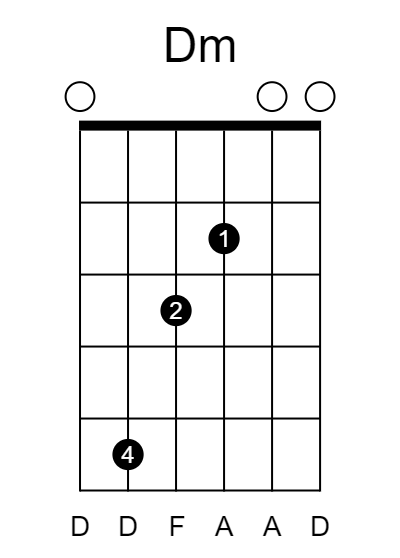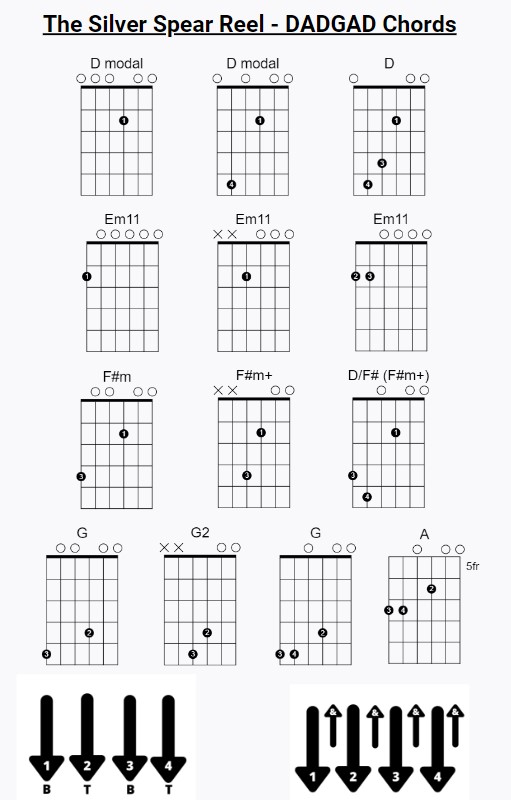Are you ready to elevate your guitar game to the next level? Welcome to the realm of DADGAD chords! Often known as “Celtic tuning” or “Modal tuning” this alternative guitar tuning has been steadily gaining traction among adventurous guitarists looking to step off the beaten track and wade into fresh, sonic territories.
In this post, we’re not just skimming the surface – we’re diving deep into the rich, resonant world of DADGAD tuning. Why? Because this tuning is a complete game-changer, and it’s the perfect moment for you to learn this fantastic tuning and revolutionize your guitar playing.
So here’s your call to adventure. Grab your guitar, flex those fingers, and join me as we delve into the fascinating universe of DADGAD chords. Trust me, you won’t want to miss a beat!
Tuning to DADGAD
Now, getting your guitar to DADGAD is easy. You merely tune down the 6th, 2nd, and 1st strings a full step from standard, et voila!
You’ll just need to begin at the familiar territory of standard tuning, E-A-D-G-B-E and tuning down your 6th string (the low E) a full step to D. A handy trick is to play your low E string and the 4th string (D) together, adjusting the pitch of your low E string down until both strings harmonize as a perfect D drone.
You don’t have to adjust your A string, D string, or G string – they can stay as they are in standard tuning.
Next on the list is your 2nd string (B), which needs to descend a whole step to A. The same process applies here: play your 2nd string and the A string (5th string) simultaneously, tweaking the B string’s pitch down until they both align as an A tone.
Finally, you lower the 1st string (high E) down a whole step to D. Do this by playing it in tandem with the 4th (D) string and adjusting as necessary.
Once tuned down, when you strum all the stings together in DADGAD what you get is an incredibly warm, vibrant sound that’s pure magic to the ears. It gives the guitar a characteristic droning, suspended sound quality.
Quick Easy DADGAD Chords
Now that we’re tuned down, let’s get some chords under our fingers and start playing out some of those big beautiful DADGAD tones.
One Finger Chords
One reason we gravitate toward DADGAD is that it simplifies certain chord shapes, making them more accessible for players of all skill levels. For example, open major and minor chords often require just one or two fingers to fret. Let’s try some of them now…
If we place our first finger on the second fret of the G string we produce a D chord, (Technically it’s a D5 chord, also known as D modal, as there is no 3rd included).
Similarly, placing our first finger on the second fret of the low A string we get a G chord (Technically it’s a G2/D).
Then placing our first finger on the second fret of the middle D string we get an A chord (Actually a A7sus4 chord, but we don’t have to worry about the complicated chord names for the moment).



These one-finger chords can you familiarize yourself with the DADGAD fretboard and open up the door to more complicated chord shapes.
But before we get there, let’s figure out the difference between standard and DADGAD chords, and why we might use DADGAD over standard in certain genres or when composing.
DADGAD vs Standard Tuning
One key difference between DADGAD and standard tuning is the open chord produced when we strum all the strings. In standard tuning, this gives us an E minor 11th chord, whereas in DADGAD, strumming all the open strings forms a Dsus4 chord. Music composed for DADGAD tends to have a more open and resonant quality due to these open strings.


Playing in DADGAD offers the opportunity to use drones on the open strings, which enhances the depth and resonance of chords and melodies. Experimenting with different chord shapes and progressions can lead to discovering intriguing sounds that may be more challenging to achieve in standard tuning.
And despite being an alternative tuning, one of the key advantages of DADGAD is its elements of similarity to standard tuning. This is because the middle three strings (D, G, and A) remain the same as in standard tuning, making the transition less challenging. This unique combination allows guitarists to explore new soundscapes and harmonic ideas, while still relying on some of their existing knowledge of chord shapes and fingerings.








More DADGAD Chords & Scales
The DADGAD tuning setup isn’t just versatile; it’s a gateway to an array of unique and beautiful chords that can elevate your music. By moving beyond traditional shapes and venturing into unfamiliar territories of chord structures, you can craft a soundscape that’s fresh, dynamic, and undeniably yours. From richly resonant open chords to nuanced, intriguing inversions, DADGAD truly broadens the horizons of your guitar’s chordal potential.
Major and Minor DADGAD Chords
Major and minor chords form the backbone of most songs. In DADGAD, you can play major and minor chords by learning a few straightforward shapes.




Movable DADGAD Chords
The convenience of creating movable chords is another selling point of DADGAD tuning. The trick lies in moving a particular chord shape along the neck to form new chords effortlessly. The beauty in DADGAD is that you don’t have to barre a chord like in standard. Let’s now compare some of the standard barre chord shapes to the equivalent DADGAD chords, so that we can start to get our heads around these new shapes.
Mastering this technique with both major and minor chords will unlock new horizons in your guitar playing.




Scales in DADGAD
Exploring scales in DADGAD tuning is an excellent way to enhance fretboard comprehension and melodic creation. We’ll start with the fundamental D major scale up the guitar neck. A scale I like to call the “Skeleton Scale“. It’s a very important pattern to learn in DADGAD and we can build a whole network of chords off of this one scale.
First practice this scale with just the inside D and G strings. Then when you are comfortable moving up and down the scale, open up those other strings and hear the big DADGAD sound ring out which you play.

It’s worthwhile also learning the D major and D minor scales across the neck in DADGAD, and then linking those scales in with their equivalent chords. We can then start to make bass runs and licks out of the scales once we get comfortable with them.




Falling into DADGAD
DADGAD’s open and resonant sound makes it a favourite choice for many guitarists. By mastering the basic open chord shapes and movable chords, we can unlock this tuning’s unique sonic characteristics. Moreover, delving into major and minor chords and scales will enhance our versatility and allow us to create new tones in whatever music genre we’re playing. Take the time to play around with these new tones, the low bass and big modal chord swells can be very addictive. Fall into and enjoy the process.
And now that we’re playing a bit, it’s nice to know where DADGAD tuning originated.
The History of DADGAD
Davey Graham was an innovative and influential guitarist whose experimentation with alternative tunings led to the creation of DADGAD. He discovered the tuning while experimenting with different ways to simplify the fingering of specific chords for his arrangements. The tuning allowed him to achieve a unique sound and facilitated his exploration of various musical styles, including Middle Eastern, Indian, and Eastern European genres.
One of Graham’s most famous compositions, “Anji,” showcases the versatility and adaptability of DADGAD tuning. The piece, which was released in 1962, quickly became a guitar classic and inspired many musicians to experiment with the tuning.
Interest in DADGAD tuning grew with the increasing popularity of traditional Irish music in the late 20th century. As a result, it has become a signature sound for many guitarists, including Pierre Bensusan, Tony McManus, and John Renbourn.
DADGAD’s Impact on String Tension
The tension of a guitar’s strings is primarily determined by three factors: the string’s mass, its length, and the pitch at which it’s tuned. So when you change the tuning of your guitar, including switching to DADGAD tuning, it does have an impact on the string tension.
This reduced tension has several implications:
- Playability: Strings with lower tension are easier to press down and bend. This can make your guitar feel more playable, especially for techniques like hammer-ons, pull-offs, and slides.
- Sound: The reduced tension can affect your guitar’s tone. DADGAD tuning is often described as having a more open or resonant sound due to the lower string tension.
- Instrument Care: Drastic changes in string tension can potentially cause issues with your guitar’s neck, such as bowing or warping over time. But going from standard tuning to DADGAD isn’t typically a big enough change to cause concern. If you frequently switch between tunings, especially more extreme tunings, it might be a good idea to have your guitar’s setup checked and adjusted as needed by a professional.
If you’re concerned, you could change your strings’ gauge and get strings made specifically for DADGAD tuning.
Playing Techniques in DADGAD
Now that we’ve gotten familiar with the basics, let’s delve deeper into the rich sonic landscape offered by the DADGAD tuning.
Navigating the Fretboard
To familiarize yourself with this tuning, it’s a good idea to experiment with different finger positions on the fretboard. Here’s the DADGAD fretboard layout so you can play around and create new sounds. Try to explore and figure out where the octave shapes are. That’s a good start which can lead to more unique chord shapes further down the line. (Tip: try and find all the D notes and their octaves).
Fingerstyle Guitar
DADGAD is an excellent tuning for fingerstyle guitar playing, as it lends itself well to complex fingerpicking patterns and intricate melodies. The similarity of the middle three strings to standard tuning provides familiarity while offering a fresh sonic landscape to explore. Many renowned fingerstyle players, such as Pierre Bensusan and Michael Hedges, often utilize DADGAD tuning in their compositions. Developing finger independence and practising picking patterns is vital for mastering fingerstyle techniques in this tuning.
Here’s a nice fingerstyle melody to start with in DADGAD tuning…


Octaves and Riffs
DADGAD tuning also enables guitarists to easily play octaves and riffs using its open string layout. The lowered 6th, middle 4th, and 1st strings create an octave relationship that makes playing melodies on three strings more accessible. Guitarists can experiment with string skipping and sliding techniques to create interesting and expressive riffs in this tuning. The open nature of DADGAD allows for quick and smooth transitions between chords, creating a seamless flow in rhythmic patterns.
Here’s a cool trick to get you playing melody and bass lines fast in DADGAD.








Capo Usage
Using a capo opens up a world of possibilities when playing in DADGAD tuning. Capo placement can alter the key, and when placed on different frets, it opens up a variety of new chord shapes and progressions. For example, placing a capo on the 2nd fret would transform the open Dsus4 tuning to an Esus4 tuning, offering a fresh set of tonal possibilities. Experimenting with capo placement in DADGAD can help guitarists expand their creativity and allows for more unique tones. And the higher you go up the neck, the more it sounds like a bouzouki, which is often used for accompaniment in Irish music.
Check out this Quick Draw Capo which I use when playing in DADGAD all the time.
But of course, you don’t have to use a capo while playing DADGAD. Let’s have a look at some examples of famous musicians who incorporate DADGAD tuning into their music.
Famous DADGAD Guitarists & Songs
DADGAD tuning has been the secret weapon of many iconic guitarists, enabling them to produce unique sounds and break new ground in music. This section introduces you to a selection of these celebrated musicians, who have utilized DADGAD to its fullest potential. Discover their signature tracks, and be inspired by the versatile melodies they’ve crafted using this distinct guitar tuning.
Led Zeppelin – Kashmir
Led Zeppelin has made a significant impact on the world of DADGAD tuning with their iconic song Kashmir. Written by Jimmy Page and Robert Plant, this influential piece features one of the most recognizable riffs in rock history. Incorporating the DADGAD technique, Page’s guitar playing is both powerful and evocative of Eastern influences.
Pierre Bensusan
Renowned guitarist and composer Pierre Bensusan is credited with elevating the DADGAD tuning to new heights. Throughout his career, he has developed a unique fingerstyle technique that makes the most of DADGAD’s versatility. Pierre’s virtuosic playing and intricate compositions draw from a range of musical styles, showcasing the endless possibilities of this tuning and inspiring countless other musicians to explore its potential. I would suggest checking out his book, simply titled ‘The Guitar Book‘. It’s amazing.
Modern Artists – Ed Sheeran
Even contemporary artists like Ed Sheeran have embraced the DADGAD tuning. Sheeran has utilized this alternate tuning to create new musical textures and experiment with different chord voicings which can be heard in his song ‘Photograph’. As more artists continue to explore DADGAD, it remains an essential tool for guitarists seeking fresh perspectives and sounds in their work.
Irish Traditional and Celtic Music
And now we get to where DADGAD really shines! It is also known as Celtic Tuning, so of course it blends beautifully with Irish and Scottish traditional music. Folk musicians in the 1960s explored this alternate guitar setup to create a distinct modal sound that complaments the tune melodies seamlessly. The open chord formations in DADGAD provide a specific tonality that adds to the traditional tunes while also offering a unique sonic landscape for experimentation.
Let’s now take all that we have learnt so far and use it to accompany an Irish reel called The Silver Spear.

More Resources and Tutorials
I have a lot more free resources on this site for you to dive deeper into the D A D G A D tuning.
- Firstly there’s the free DADGAD cheatsheet, so you can have all the main DADGAD chords, scales and chord progressions at your fingertips.
- Secondly, there’s the resources section.
- Here you’ll find full tutorials on DADGAD Chords
- Traditional Irish guitar accompaniment
- Irish rhythm & strumming lessons
- Song tutorials
- Techniques & tricks
- And free guitar Tabs & notation videos.
- And if you want to really master DADGAD, check out my DADGAD Guitar Courses, where I teach everything I know, so that you can avoid all the time waisting, and get playing fast!
Conclusion
In our exploration of DADGAD chords, we have discovered the versatility and unique sound that this tuning offers. It provides a distinctive and rich tonal foundation for experimenting with new chord shapes and progressions.
DADGAD tuning is not only popular in Irish and folk music but also holds potential for diverse genres due to its versatility. I would encourage you to dive deeper into the world of alternative tunings and discover the creative possibilities that this tuning can offer.
Embrace the challenge of mastering DADGAD chords and let this alternative tuning fuel your creativity. Whether you’re a beginner or a seasoned guitarist, expanding your tunings repertoire is an opportunity to unlock new artistic expressions and elevate your playing skills.
So go ahead, grab your guitar, tune it to DADGAD, and begin your journey into the world of new and exciting sonic textures. Happy strumming!
If you found this blog post helpful and want to continue your journey in Irish music, don’t forget to subscribe in the footer of this page. You’ll receive updates about new blog posts, tutorials, and more.
If you’re hungry for more DADGAD guitar knowledge, be sure to check out my song tutorial post on “Red is the Rose.” In that article, we dive into how to bring the DADGAD tones to this old Irish song with beautiful chord voicings.
Finally, have you ever experimented with alternative tunings like DADGAD? What has been your experience, and what new possibilities have opened up for you as a guitarist? I invite you to share your DADGAD journey with fellow guitar enthusiasts. Let us know your favourite DADGAD songs or guitarists. Connect with other musicians, share your experiences, and learn from one another. Together, we can continue to inspire and support each other’s musical growth.






